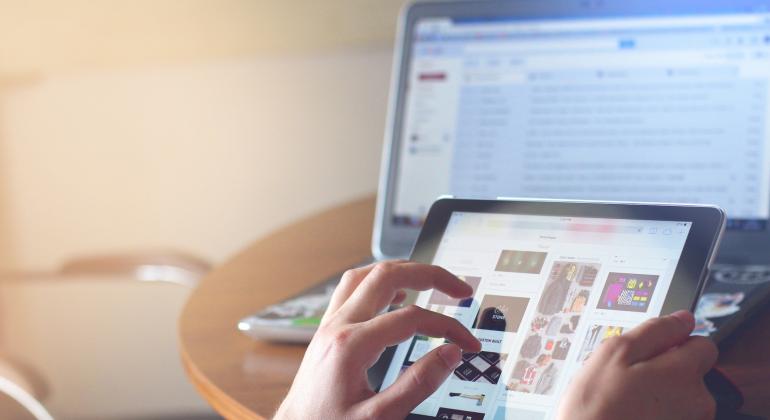Jalal Ismaili & El Houcine Ouazzani Ibrahimi
Springer Science+Business Media New York 2016
Abstract Assistive Technology (AT) revolutionized the process of learning for special needs students during the past three decades. Thanks to this technology, accessibility and educational inclusion became attainable more than any time in the history of special education. Meanwhile, assistive technology devices remain unreachable for a large number of students with disabilities, especially in under-developed and developing countries like Morocco due to a number of factors, especially, availability and affordability. Mobile learning, using smartphones and tablets in particular, may provide alternative solutions as special education tools in such countries. Additionally, open source platforms, particularly Google play store with all the applications it accommodates for disabled people, may obviate the need for monofunctional, sometimes expensive, AT devices. The present paper sets out to investigate potentials of using smartphones and tablets as alternative learning tools for assistive technology devices within formal and informal learning environments. It compares seven free Google Play medical apps with seven assistive technology devices at the level of functionality and affordability. The apps are of relevance to cases of physical as well as mental disabilities, namely hearing impairment, visual impairment, autism and speech articulation disorders.
1. Introduction
Assistive Technology (AT) contributed to enhancing disabled people’s lives to become synonymous with empowerment, hope and encouragement that place those students in front of Breal-world^ experiences (Akpan and Beard 2013). According to some recent comprehensive studies, autonomy and self-determination were mentioned as the most important benefits of AT (Copley and Ziviani 2004). Today, and with the growing interest in pedagogical and instructional technologies, researchers try to come up with solutions that can foster and maximize the integration of special needs students within regular mixed classrooms.
Although AT offers better learning chances for some students with disabilities, it falls short of meeting the needs of a large number of cases due to several factors that undermine the learning outcomes to some extent. Some ATs do not fulfill some requirements related to: 1) Usability/accessibility necessary to make the application or gadget easy to use; 2) Flexibility/adaptability, which make the application or gadget customizable for both teacher and student to meet their teaching/learning needs; 3) Mobility, guaranteeing freedom of movement between different locations inside and outside school (Fernández-López et al. 2013). In addition, underprivileged communities, in Morocco for instance, have major issues with affordability, as there is no government subsidization for such devices. Some AT devices reviewed in this paper seem to be theoretically promising, but if we consider the cost factor, they may seem unreasonably expensive and beyond reach for the majority of Moroccans. Finally yet importantly, only a few researches conducted on Mobile Learning (M-Learning) focus on students with special education needs, or they neglect the affordability factor, which we think is pivotal in this regard.
The present study aims to shed light on solutions that can help foster the outcomes of both formal and informal learning environments by means of mobile gadgets, particularly smartphones and tablets, and open source apps that proved to be efficient and Bpractical learning alternatives^ (Sharples et al. 2009). It reviews functionalities of some Assistive Technology devices for people with hearing impairment, visual impairment, autism and speech articulation disorders, and proposes alternative free of charge open-source applications. In addition, the paper lists and analyses the community of users’ feedback submitted by special needs people on Google play store.
The present paper is structured as follows: Section 2 examines the theoretical framework of the study. Section 3 addresses the methodology of research used. Section 4 proposes some alternative applications and the solutions they may offer. Section 5 discusses the findings of the previous section. Limitations of the study for future work are in section 6, followed by a conclusion in section 7.
2. Background of study and related work
This section is devoted to the conceptual framework of the paper where we shed light on some related key concepts and portray the situation of special needs students in the Moroccan educational system.
2.1. Special needs students in Morocco and the state obligations
The Moroccan educational system during the past 20 years has gone through a number of challenges and failures that led to, almost, a total breakdown, as described by King Mohamed VI,1 which necessitated the intervention of the government in two occasions by means of the National Charter of Education in 1999, and then the Emergency Plan in 2009. Both procedures sought to redeem the flaws of the educational system including those aspects related to the education of special needs students. Article 12 of NCE states that BThe education system works on achieving the principle of equality of citizens, offering equal opportunities and the right for all girls and boys to education, whether in rural or urban areas, in compliance with the constitution of the Kingdom^ (Special Commission for Education 1999). The charter further details these rights in Article 13 by committing to insure fundamental education to all Moroccan students until they reach the working-age and adapt the education system to the needs of all individuals (ibid). Article 14 of the charter addresses cases of special needs students as it urges education authorities to strive as much as possible to guarantee students with physical or cognitive disorders the right to barrier free environments as well as adequate programs and coaching that will secure their social and professional integration.
Internationally, Morocco signed the United Nations Convention on the Rights of the Child In January 1999, stipulating in Article 23 Bthat a mentally or physically disabled child should enjoy a full and decent life, in conditions which ensure dignity, promote self-reliance and facilitate the child’s active participation in the community^ (Assembly 1989). In 2007, Morocco signed the Convention on the Rights of Persons with Disabilities and Optional Protocol that enshrines Bthe right of persons with disabilities to education. With a view to realizing this right without discrimination and on the basis of equal opportunity^. The convention addresses, for the first time, the universal right of special needs students to information and communication technologies (ICTs) on equal basis without discrimination. Article 9 of the convention attributes accessibility to education, employment, transportation … as finalities, to the availability of ICTs (Narasimhan and Leblois 2015).
The above-mentioned treaties, and many others, constitute the legal framework for the policy of national education towards students with special needs, yet many specialists and activists find them dysfunctional and inoperational, mostly due to the poor managerial mentality of decision makers in public institutions (El Hallouly 2014a, b). According to a report issued by the high commission of planning in 2004, the proportion of people with disabilities exceeds 5 % of the Moroccan population making up 1,53 million (Haut-Commissariat au Plan 2009). Unfortunately, only a small number of students at the school age have access to schools (around 15 % of applications), and the majority of host institutions are owned by civic society (El Hallouly 2014a, b). The factors that lead to this marginalization and exclusion are numerous, but the difficulty of inclusion and shortage of necessary financial resources remain the dominant factors.
2.2. M-learning
Mobile learning as an emerging discipline has evolved as a result of the maturity of other related disciplines. Distance learning (d-learning), as an umbrella term for both electronic learning (e-learning) and mobile learning (m-learning), dates back to 18th and 19th century when scholars took advantage of the European industrial revolution by means of print technology, transportation and the flourishing postal communication (Lam et al. 2010). The technological revolution of 20th century gave a boost to the process when learning could cross borders thanks to television, radio, audio and video tapes, etc. leading to the emergence of e-learning. The process kept evolving until mobile phones and tablets became widely recognized as learning tools.
While Traxler (2009) refers to m-learning as simply BMobile e-learning^, Kukulska-Hulme and Shield (2008) views m-learning as BLearning mediated via handheld devices and potentially available anytime, anywhere. Such learning may be formal may be informal. When a gadget fails to fulfill all of the three above mentioned criteria, it does not fall within the m-learning model. Though e-learning is now viewed as an independent discipline on its own, m-learning and Mobile Assisted Language Learning (MALL) are still making their way into academic research (Kukulska-Hulme and Shield 2008) i.e., there are very few literatures that cover certain topics such as mlearning for specific educational purposes. The rapid maturity of this new field, however, seems to be promising due to the constant evolution of related technologies in terms of technical capabilities and affordability.
With the development of technologies and related learning platforms, Man came to realize that the learning process may occur in contexts other than the traditional classroom. Learning, as a life-long process which incorporates exploration, exchange and collaboration, cannot be confined by the illusion of stability context (Sharples et al. 2009). These interpersonal mechanisms of learning require openness to other people, groups and experiences that are not sharing the same physical space with us. This participatory model of learning shared between learners of different linguistic and cultural backgrounds across the seas, can help both educators and learners leap over the old paradigm of learning with time and space constraints (Chun 2015). Now that the factors that hindered effective communication between learners such as expensive licenses, connectivity issues, etc. are eliminated, open source platforms, free Wi-Fi and free content websites will increase chances of communication, interaction and participation in the learning process (Chun 2015).
2.3. Assistive technology
Assistive Technology as described by Lancioni et al. (2012) refers to Ba variety of devices (and services related to their use) aimed at helping persons with disabilities and special education/rehabilitation needs to function better within their daily context and achieve a higher quality of life^. It refers to all technological devices that can help people with physical or cognitive impairments overcome the hardship they may get through when they need to depend on their own physical capabilities at school or in real life situations. The definition implies that the term involves hardware devices in addition to the operating software and applications used by people with special needs. Thanks to the technological development during the 1970s and 1980s and the inclination of legislators all over the world to adopt policies that promote the use of Information and Communication Technologies (ICTs) for disabled people, Assistive Technology (AT) was introduced to schools in Canada and the USA and different parts of the world with Personal Computers (Hollier and Murray 2006). It actually revolutionized the inclusion of students with certain impairments within the world of knowledge.
Now the use of the term in academia is broader that it also covers material targeting gifted students with exceptional performance and high IQ scores. Although these students may not have any apparent issues that make them disabled or hinder their inclusion at school, their educational outperformance may result in undesirable feeling of annoying uniqueness and difference. Consequently, they are also considered as special needs students qualified to benefit from AT programs (Brody and Mills 1997).
As there are different disabilities, AT areas of intervention include physical impairments such as visual impairments, mobility impairment, deafness and hard of hearing… and mental disabilities such as autism disorders, communication disorders and learning disabilities. We, however, have limited the scope of the present study to focus on cases of visual and hearing impairments in addition to certain cases of autism and speech articulation disorder.
The paramount obstacles that undermine the integration of AT tools at schools, at least in underdeveloped countries, are affordability and accessibility. At the time this article is being written, most of these gadgets, which are likely to be monofunctional, are not affordable by a large number of Moroccan families and fall short of fully satisfying the special needs students’ expectations. Research into inexpensive and easily portable AT devices requires further attention (Kukulska-Hulme and Shield 2008).
2.4. Related work
Most studies about the use of mobile devices for educational purposes tend to focus on ordinary students with no disabilities. Godwin-Jones (2011), for instance, examined ways by which a smartphone or a tablet could be used by language learners and the factors leading to the ever-increasing interest in such devices. Lately, m-learning specialists became more interested in special needs students. Akpan and Beard (2013) outlined assistive technologies that can help teachers enhance academic outcomes of students. A research team from the University of Granada and the University of Murcia introduced a mobile platform called Picaa based on iOS targeting special needs students and operating on iPad and iPod devices (Fernández-López et al. 2013). With the increasing number of open source apps, selecting the right application that could meet the needs of disabled students becomes harder and more confusing. Ok et al. (2015) came up with an evaluation rubric for instructional apps for teaching students with learning disabilities. The evaluation aims at helping teachers as well as parents evaluate apps and choose the ones that may be most adequate for their children’s particular needs.
Hamidi et al. (2014) presented an interesting case study about a Do-It-Yourself open-source speech-generating device that might be efficient, affordable and effective. Chai et al. (2014) introduced an iPad application to promote early literacy development in young children with disabilities. A similar project investigating the use of iPads by special needs students was conducted by Chmiliar and Anton (2015). The project examines how the iOS device is used by post-secondary students and related apps. Young learners with special needs drew the attention of Chmiliar (2014) who inspected their attitude and their parents’ whilst using the iPad. Ludi et al. (2014) introduced a low-cost tablet-based system to help students with partial sight impairment access math and science lecture material inside and outside the classroom. Academic paper interested in Android apps for special education are, for some reason, still scarce compared to those working on iOS. Shanmugapriya and Tamilarasi (2011) were aware that Android OS along with entry-level mobile devices are ideal for ubiquitous learning environments in certain countries; thus, they introduced an application for Android mobile gadgets using web services. The application, however, is not targeting special needs students in particular.
3. Methodology
Most studies and paper interested in ICT, E-learning and M-learning tend to focus on ordinary students with no disabilities. Research targeting students with disabilities is highly required if we take into account the benefits it may bring about to this category of students. The related studies listed above tried to mend this gap by focusing on the functional/operational aspects of mobile gadgets targeting special needs students, but most of them ignored the purchasing power of users. Although iOS devices are known for their exceptional performance compared to other products, they remain out of reach for underdeveloped countries. In addition, none of these studies presented a large-scale evaluation by special needs people whose feedback can provide pertinent idea about the worthiness of the app.
The present study embraces both quantitative as well as qualitative methods. It lists and compares the features and functionalities of seven AT devices for physically and mentally disabled people with seven free Google Play medical apps that can carry out the same functions. To evaluate the worthiness and effectiveness of these apps, it was imperative to examine the apps’ reviews. With the increasing number of open-source apps, costumers’ reviews help in shaping an initial conception about apps, especially medical ones (Obiodu and Obiodu 2012). Google play reviews contain important information about the apps, what they do and how they could be improved; hence, they are informative for both the developer and the user as well (Ha and Wagner 2013). A recent behavior survey concluded that 98 % of online shoppers consider other customers’ reviews as a major purchase decision factor (Liu et al. 2013). We believe that the star rating system and the number of downloads are capable of telling whether the application is worth trying or not. Textual reviews, on the other hand, may help to better appraise the app and provide answers for why it is considered Bgood^ or Bbad^. According to Liu et al. (2013), the sentiment analysis approach is a popular technique used to evaluate summarize and analyze consumers’ textual reviews submitted for online products, but since our primary scope of interest is the cost factor, only textual reviews posted by special needs people are listed in the study.
To get the highest accurate results, we decided to work on Google play store for the following reasons:
- As an open source platform, Google play offers a huge database of free apps to choose from.
- The medical apps are tested by a wide community of users. Some reviews are sub mitted by special needs people or by a kinsperson.
The chosen apps had to meet the following criteria:
- Be of relevance to people with hearing impairments, visual impairments, autism and speech articulation disorders.
- Be downloaded by at least 50,000 users.
- Be reviewed by at least 500 users.
- Get at least a 3 star rating on 1–5 scale.
- Be tested by people who declare using them as alternatives to AT devices.
To evaluate the proposed apps, we tried them on a Samsung Galaxy Tab’3 and Samsung Galaxy Core 2 running under Android Jelly Bean. The choice of devices is because they are affordable to the majority of users and possess the basic requirements to run the apps with no problems.
4. Alternatives and solutions
This section introduces and compares seven AT devices and seven alternative medical apps for students with hearing impairment, visual impairment, autism and speech articulation disorder.
4.1. Available ATs for hearing impairments
4.1.1. Partial hearing impairment
Among many AT devices for people with hearing impairments, two remain more popular:
- Hearing aid: a little device mounted on behind the ear. In Morocco it costs around 300 US$, which remains hard to afford by a large segment of the Moroccan population.
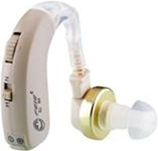
- Frequency Modulation (FM) System: a system which consists of a transmitter microphone used by the teacher, a receiver and headphones the student wears. In addition to cost, the mechanism seems not practical at school and subject to damage if used by several teachers daily. A decent quality device costs around 500 US$ and the price may go up to 1500 US$ or more.

4.1.2. Total hearing impairment
For people who suffer from total deafness, MotionSavvy engineers have developed a device they named UNI that would convert sign language into speech and speech into text.2 The product, which is a first of its kind, is expected to be commercialized in fall 2015. The tablet-like device will cost around 500$, which again brings into question the affordability issue.
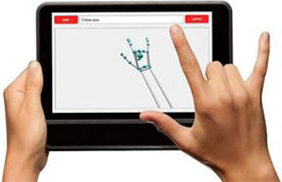
4.2. Alternative apps for hearing impairments
Google play places at the disposal of special needs students a number of applications that may accomplish the very same results. It is all about an operating software that can render a smartphone or a tablet into an AT gadget.
4.2.1. Partial hearing impairment
For students who suffer a partial hearing impairments we suggest two applications that may be of significant relevance.
a. Petralex Hearing aid (by IT ForYou): The application simulates the Frequency Modulation (FM) mechanism with the advantage of being more practical (totally wireless) and free of charge. With a Bluetooth headset, the student may place the phone/tablet close to the teacher to get better results. An auditory test should be conducted before the first use to guarantee a customized performance. The app is downloaded over 100.000 times with a four star rating. It is categorized as a medical app as well. The application requires 4.1 Android environment or higher and is easy to install.
To date, the application could gain the satisfaction of 75 % of reviewers. Users who declared having hearing impairments expressed their admiration for the application, being Bmore elaborate^ compared to others for the same purpose.
Sixteen percent of unsatisfied users were not happy due to the following limitations:
- Some compatibility and technical issues that disrupted the installation.
- A mediocre amount of echo.
- The sound delay of 1 s, which is normal in this kind of apps, is a bit confusing.
b. Hearing Aid with Replay (by Lemberg Solutions): is a medical app and works with wired as well as Bluetooth headsets to amplify the surrounding sounds with a noise-reducing feature. Like the previous app, it simulates the hearing aid and FM gadgets, but can also record audio clips. It was downloaded over 100.000 times and was given a 3,7 star rating.
To date, the application is admired by 66 % of the free version reviewers.
Twenty-five percent of users were not satisfied with the app due to the following:
- Sound delay of 1 s.
- Technical and compatibility issues during the set up.
4.2.2. Total hearing impairment
The Deaf and Hearing Impaired (by MonCaptain): is a medical app intended to assist the deaf or hearing-impaired people by alerting them with the vibration and the flash light when a loud sound is made in the vicinity (cars, doorbell, alarm, crying babies…). It was downloaded over 50.000 times and got a 4.3 star rating. What makes this application suitable as an alternative AT for students is the fact that it is equipped with a voice recognition feature which converts speech to text and text to speech. Thus, a student who is close enough to someone talking, in a clear voice, e.g., a teacher, can have the speech rendered into text on the screen.
To date, the free-of-charge application gained the satisfaction of 82 % of reviewers.
On the other hand, the downsides of the application reside in the fact that the voice recognition feature requires Wi-Fi or mobile internet coverage during usage. In addition, the app does not differentiate between the different loud sounds in the vicinity; thus, it reacts the same way as mentioned by two reviewers. Finally, the voice recognition feature provides satisfactory results with English language solely. There were only a few negative ratings stating why the app is not up to the users’ expectations.
4.3. Some available ATs for partial visual impairments
a. Electronic magnifier: helps people with certain brain damages or visual impairments. This gadget costs between 300 and 1300 US$ depending on the device’s features. It is equipped with a zoom camera and a storage option. Unfortunately, it is worth mentioning that the gadget is hard to find in Morocco.
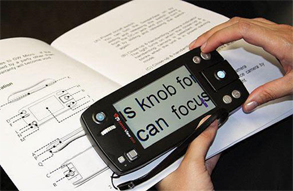
b. Spelling keyboard for visually impaired students: the keyboard helps students spell words and avoid typos through built in speakers.
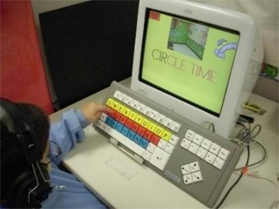
4.4. Alternative apps for partial visual impairments
a. Magnifier (by mmapps mobile): for people who have vision issues, the application turns smartphones and tabs into digital magnifiers. It offers almost all the features of conventional magnifiers including zoom, focus, light, saving and sharing images, etc. The app was downloaded over 1.000.000 times and got a 4.3 star rating.
To date, 84 % of reviewers were satisfied with the app.
Ten percent of reviewers were not satisfied with the app as they had issues with the following:
- Installation and compatibility issues.
- Focus issues.
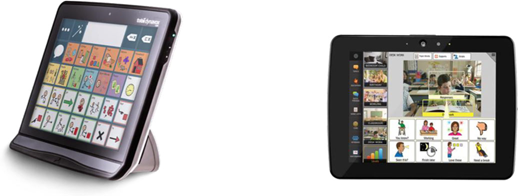
Fig. 1 a Tobii Dynavox i-series, b Tobii Dynavox t-series
b. Big Buttons Keyboard Standard (by Chicago Logic Inc.): for students who have sight impairment, the app substitutes the default tiny keyboard with a larger one. The keyboard takes more than half the screen, offering better visibility for shortsighted users. The app was downloaded over 1.000.000 times and given a 4.2 star rating.
To date, 78 % of all reviewers expressed their satisfaction with the free app.
Thirteen percent of reviewers complained about the following:
- They did not know how to switch from the device default keyboard to BB’s.
- They did not like the portrait arrangement of keyboard. They had to keep their devices in a landscape mode.
- They wanted to see more features.
4.5. Some available ATs for students with autism and speech articulation disorder
Tobii Dynavox: Dynavox (Fig. 1) is a leading trademark in autism industry. The gadgets they manufacture are speech-generating devices that can be controlled through gaze interaction via an optional built-in eye tracker for people who endure cognitive issues including autism. The Tobii Dynavox comes in t-series and i-series for a price ranging between 5000$ and 12,000$ equivalent to a fortune in Morocco. Though the gadget’s developers claim that the device helps students develop a sort of independence and autonomy, the device’s outcomes are questionable.
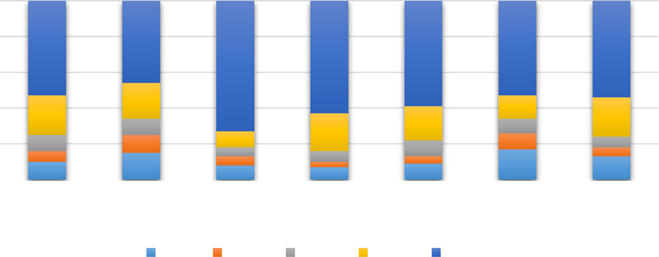
Fig. 2 Database users’ ratings
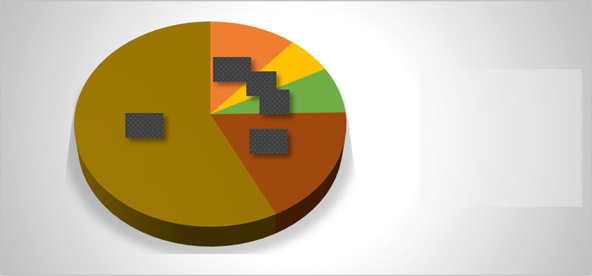
Fig. 3 Total users’ satisfaction rates
4.6. Alternative apps for students with autism and speech articulation disorder
a. JABtalk (by JABstone): is a free speech communication application that renders mobile gadgets into Augmentative and Alternative Communication (AAC) devices. It was designed to help special needs children who suffer from autism and speech articulation issues. The app was downloaded 50,000 times and got a four star rating.
To date, the app was admired by 76 % of reviewers.
Eighteen percent of users were not happy with the app because of the following:
- Installation issues.
- Failing to understand the concept of the app.
b. TapToTalk (by assistyx llc): this application renders smartphones and tablets into AAC devices. It is highly recommended for special needs children with autism, cerebral palsy, apraxia and speech delays. It helps these children communicate and interact with their mobile gadgets by tapping pictures and repeating what is said.
To date, 66 % of reviewers were happy with the app.
Twenty-six percent of reviewers who were not happy with the app mentioned the following reasons:
- They had issues activating the app via their email.
- Their gadgets underwent compatibility issues.
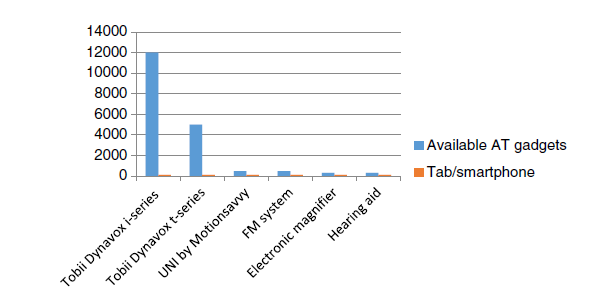
Fig. 4 Gadget cost comparison
Table 1 Mobile gadgets saving percentage
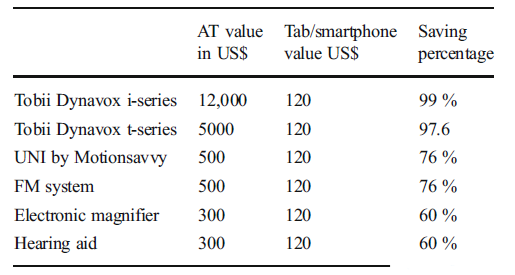
Fig. 4 Gadget cost comparison
5. Discussion of results
The applications listed above are but a few examples of apps developed by the community of committed developers thanks to the open source technology. Numbers of downloads as well the ratings these apps received suggest that they are very competitive to other paid iOS apps and AT devices. None of the iOS apps introduced in the related work section could exceed the number of downloads of these Google Play apps. Textual reviews (see appendix), which included words like Bgreat^, Bexcellent^, Ba must have^, are subjective enough, but they reveal the motivation, sense of inclusion and enthusiasm of those special need people to learn and attain higher self-sufficiency levels, especially that they tried the apps themselves. These apps, and as such, can certainly empower students within formal and informal learning environments, and achieve larger margins of autonomy and self-confidence. A motivational environment where there is a supportive family, a competent instructor and affordable technology would have a positive impact on special needs students and their performance at school (Bandura 1986) (Liu and Hong 2007).
The present study findings internalize the fact that a free app does not have to be trivial; the majority of app reviewers were satisfied with the results obtained (Figs. 2 and 3). By the same token, there is no guarantee that a 12,000$ device would meet the customer’s particular needs and expectations.
By comparing the potential sums of money invested in conventional AT devices listed above with the one invested in a decent mobile gadget (a tablet or a smartphone) capable of running the database applications, one would find it a bit challenging to justify the substantial difference (Fig. 4). For the irony, that very same mobile gadget is capable of performing the functionalities of all these AT devices and much more. Consequently, our proposed apps along with the low-cost mobile gadgets could reduce the amount of money invested to help special needs students up to 99 %. i.e., some assistive technology devices could cost the user 100 times what they may pay for a smartphone or a tablet (Table 1).
6. Limitations of study
The privileges put up by open source technology and mobile gadgets are confined by certain limitations that require further attention. First, most of these apps are available in English, and users are compelled to have a basic command of the language e.g., some voice recognition, text-to-speech and speech-to-text apps supporting other languages (French and Arabic) did not deliver satisfactory results. Second, discussions with specialists from Morocco reveal that some special education instructors may not trust their students’ capability to use tabs and smartphones by themselves, may not consider tabs and smartphones as effective teachings aids, or may not be qualified to work methodically with special needs students. Finally, in spite of the existing state obligations towards this category of students and signed treaties in this regard, the Moroccan government efforts to promote research in the field and develop open source apps remain very limited. Civic society and personal initiatives are the essential actors without which special needs people in Morocco would undergo greater challenges.
7. Conclusion
In this article, we compared seven open source medical apps with seven Assistive Technology devices for people with hearing impairment, visual impairment, autism and speech articulation disorders. The comparison was based on affordability as well as efficiency criteria. Since m-learning gadgets have proved to be capable of meeting the expectations of special needs people, at least at the level of affordability and reliability, we believe they have a lot to give to students in underdeveloped and developing countries like Morocco, and can help them achieve better chances to educational and social integration. The study findings prove that mobile gadgets, particularly smartphones and tablets, along with open source applications are efficient alternatives to the monofunctional AT devices in both formal as well as informal learning environments. Google play store offers a large number of apps that have been tested by thousands of special needs people who generally expressed their satisfaction in textual reviews. We find these reviews reflective of the empowerment and self-sufficiency these apps have given at no cost. This positive feedback make us assume that the open source community of developers have succeeded to humanize technology that was governed by the laws of profit making for a while.
Appendix
Below are a few examples of textual reviews submitted by special needs people or their kinship:
Petralex Hearing aid (by IT ForYou):
- I have had hearing issues since the military…a lifesaver when you can’t afford hearing aids. (John O., Dec 13th 2015)
- I’m 50 years hearing impaired and this app is the best clarity I’ve ever heard in any hearing aid (Bryan H., Dec 13th 2015)
- I am very hard of hearing. I have used and bought multiple hearing aid apps. This is the first one that actually works… (Heather M., Jul 2nd 2015)
Hearing Aid with Replay (by Lemberg Solutions):
- Love it. Was really easy to use and satisfying the impaired alike (Anna P., Jan 25th 2015)
- I am partially deaf but this software has helped me a lot (Subramaniam P., Jun 11th 2014)
- Best hearing helper I’ve tried. Sometimes I just need to hear things louder (Jim M., Sep 03rd 2014)
The Deaf and Hearing Impaired (by MonCaptain):
- I am hard of hearing I love to carry this to meeting in audio people. I want to hear what they were saying in conferences(Kong V., Jun 10th 2015)
- Will help me a great deal at work (Albert I., Mar 08th 2015)
- Excellent app for the deaf and hearing impaired … I’m deaf … when I see it flashing I could get my message (Abhijeet C., Dec 20th 2014)
Magnifier (by mmapps mobile):
- This app is simply incredible. IF YOUR EYESIGHT ISN’T PERFECT: please INSTALL THIS ASAP … This is going to (somehow) save a life 1 day. (Jeff A. Mar 29th 2015)
- For those of you who are visually impaired like me, this app is for you (Brian P., Mar 18th 2015)
- I have a hard time seeing due to vision loss from diabetes … This app is awesome (Alejandro N. Jan 12th 2015)
- My dad is going blind and has diabetes, he needs to be able to see enough to read his glucose meter and injections. He asked me to find an electronic magnifying device but they are over 500$! I found this app (free!) … (Barnum A. Dec 10th 2014).
Big Buttons Keyboard Standard (by Chicago Logic Inc.):
- As a senior with diminished eyesight and stone fingers, the BB Deluxe gets it done for me. (Keith H., Mar 13th 2015)
- This app has made my life much easier, for sure! With poor eyesight .. life has become a bit brighter (Google user Jan 1st 2014)
- This app is great for when I’m without my residing glasses (Jenna M., Oct 24th 2013)
TapToTalk (by assistyx llc):
- Fantastic app. I am a Registered Respiratory Therapist who works closely with Speech Therapists. We specialize in weaning long-term vent supported patients with artificial airways. This is a God send. Thank you.
- I have intermittent aphasia. This is a God send
- The free app is pretty cool. Has been useful for my son who has autism
JABtalk (by JABstone):
- Finally an app that works for my speech challenged son. We have been working with great speech therapists, but certain things haven’t clicked… No joke! Excited at possibilities of this app because of his newfound motivation to talk…(Myumi C., Aug 08th 2015)
- Absolutely love this app. I have used it to affordable turn two android devices into AAC devices for my nonverbal son…I’m even adding it to my phone so that when my son doesn’t have the other devices available, he can still communicate… (Kim J., Aug 02nd 2014)
- My son is non verbal 4 years old with Autism and this is amazing to help him communicate with us! (Lisa T. June 10th 2015)
References
Akpan, J., & Beard, L. (2013). Overview of assistive technology possibilities for teachers to enhance academic outcomes of all students. Universal Journal of Educational Research, 1(2), 113–118.
Assembly, U. G. (1989). Convention on the Rights of the Child. United Nations, Treaty Series, 1577(3).
Bandura, A. (1986). Social foundations of thought and action: A social cognitive theory. Englewood Cliffs, NJ: Prentice-Hall, Inc.
Brody, L. E., & Mills, C. J. (1997). Gifted children with learning disabilities: a review of the issues. Journal of Learning Disabilities, 30(3), 282–296.
Chai, Z., Vail, C. O., & Ayres, K. M. (2014). Using an ipad application to promote early literacy development in young children with disabilities. The Journal of Special Education, 0022466913517554.
Chmiliar, L. (2014). Learning with the iPad in Early Childhood. In Computers Helping People with Special Needs (pp. 579–582). Springer International Publishing.
Chmiliar, L., & Anton, C. (2015). The iPad as a mobile assistive technology device. Journal of Assistive Technologies, 9(3), 127–135.
Chun, D. (2015). Intercultural understanding in the new mobile learning environment. International Journal of Learning Teaching and Educational Research, 10(2).
Commission Spéciale Education Formation. (1999). Charte nationale D’éducation et de formation (pp. 47-48–58-59).
Copley, J., & Ziviani, J. (2004). Barriers to the use of assistive technology for children with multiple disabilities. Occupational Therapy International, 11(4), 229–243.
El Hallouly, H. ( وضعية الاطفال المعاقينفيالمغرب .( 2014 | Tanmia.ma. Tanmia.ma. Retrieved 29 September 2015, from http://www.tanmia.ma.
Fernández-López, Á., Rodríguez-Fórtiz, M. J., Rodríguez-Almendros, M. L., & Martínez-Segura, M. J. (2013). Mobile learning technology based on iOS devices to support students with special education needs. Computers & Education, 61, 77–90.
Godwin-Jones, R. (2011). Emerging technologies: mobile apps for language learning. Language Learning and Technology, 15(2), 2–11.
Ha, E., & Wagner, D. (2013). Do android users write about electric sheep? Examining consumer reviews in google play. In Consumer Communications and Networking Conference (CCNC), 2013 IEEE (pp. 149–157). IEEE
Hamidi, F., Baljko, M., Kunic, T., & Feraday, R. (2014). Do-It-Yourself (DIY) assistive technology: A communication board case study. In Computers Helping People with Special Needs (pp. 287–294).
Springer International Publishing.
Haut-Commissariat au Plan,. (2009). Population en situation de handicap au Maroc; Profil Demographique Et Socio-economique (pp. 9–10). Haut-Commissariat au Plan. Royaume du Maroc.
Hollier, S., & Murray, I. (2006). The evolution of E-Inclusion: Technology in education for the visionimpaired. GLADNET Collection, 341.
Kukulska-Hulme, A., & Shield, L. (2008). An overview of mobile assisted language learning: from content delivery to supported collaboration and interaction. ReCALL, 20(03), 271–289.
Lam, J., Yau, J., & Cheung, S. K. (2010). A review of mobile learning in the mobile age. In Hybrid learning (pp. 306–315). Springer Berlin Heidelberg.
Lancioni, G. E., Sigafoos, J., O’Reilly, M. F., & Singh, N. N. (2012). Assistive technology: Interventions for individuals with severe/profound and multiple disabilities. Springer Science & Business Media.
Liu, C. C., & Hong, Y. C. (2007). Providing hearing‐impaired students with learning care after classes through smart phones and the GPRS network. British Journal of Educational Technology, 38(4), 727–741.
Liu, J., Sarkar, M. K., & Chakraborty, G. (2013). Feature-based Sentiment analysis on android app reviews using SAS® text miner and SAS® sentiment analysis studio. In Proceedings of the SAS Global Forum 2013 Conference (Vol. 250).
Ludi, S., Timbrook, M., & Chester, P. (2014). A tablet-based approach to facilitate the viewing of classroom lecture by low vision students. In Computers helping people with special needs (pp. 591–596). Springer International Publishing.
Narasimhan N., & Leblois A. (2015) Making mobile phones and services accessible for persons with disabilities. The International Telecommunication Union and G3ict – The global initiative for inclusive ICTs, www.itu.int/ITU-D/sis/PwDs/Documents/Mobile_Report.pdf.
Obiodu, V., & Obiodu, E. (2012). An empirical review of the top 500 medical apps in a European android market. Journal of Mobile Technology in Medicine, 1(4), 22–37.
Ok, M. W., Kim, M. K., Kang, E. Y., & Bryant, B. R. (2015). How to find good apps an evaluation rubric for instructional apps for teaching students with learning disabilities. Intervention in School and Clinic, 1053451215589179.
Shanmugapriya, M., & Tamilarasi, A. (2011). Designing an m-learning application for a ubiquitous learning environment in the android based mobile devices using web services. Indian Journal of Computer Science and Engineering, 2(1), 22–30.
Sharples, M., Arnedillo-Sánchez, I., Milrad, M., & Vavoula, G. (2009). Mobile learning (pp. 233–249). Springer Netherlands.
Traxler, J. (2009). Learning in a mobile age. International Journal of Mobile and Blended Learning, 1(1), 1–12.
Websites
El Hallouly, H. ( وضعية الاطفال المعاقينفي المغرب .( 2014 | Tanmia.ma. Tanmia.ma. Retrieved 29 August 2015, from Tanmia.ma
